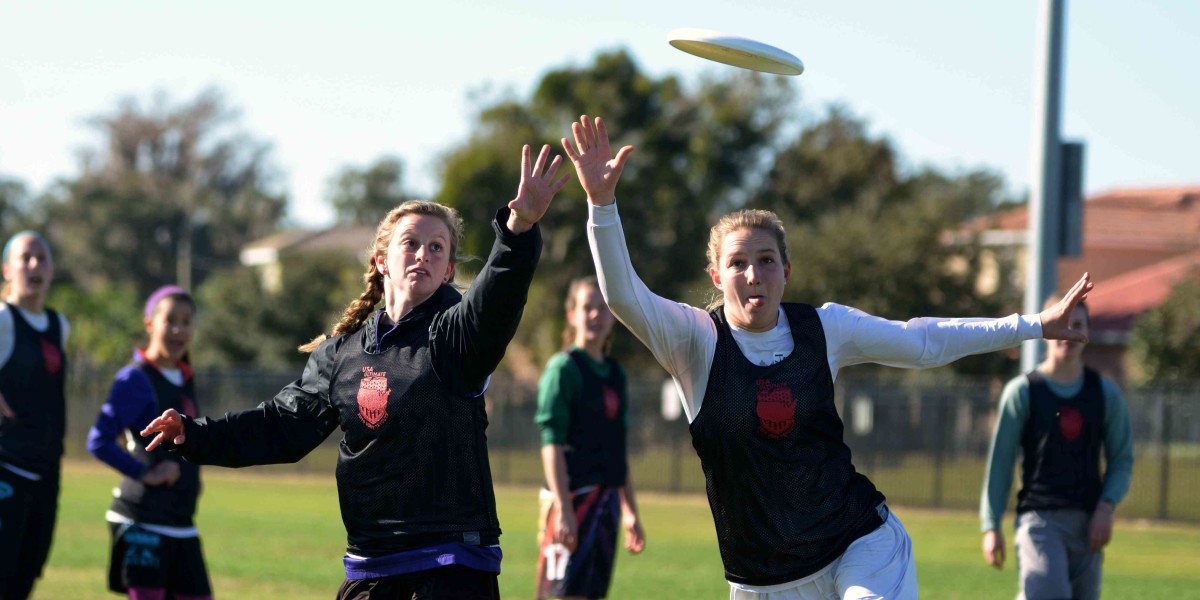 Photo: Billy Dzwonkowski, Ultiphotos
Photo: Billy Dzwonkowski, Ultiphotos
I’ve been talking and writing a lot lately about goal-specific training for ultimate. In my new 10 Weeks to Awesomeness classes (and my work with pro leagues), my athletes break into smaller groups to tackle exercises designed to help them progress towards their individual objectives. Defensive quickness is one of the most often selected areas for growth, and it’s definitely important to work hard in the gym to develop the strength necessary to change directions and sky people. But if this is an area where you’d like to improve, you’ve also got to get your footwork up to snuff! (Tl;dr, here’s a handy footwork for defense video resource!) We see highlight layout blocks and grabs all the time – what we don’t often see is the moments before those blocks, the shutdown D that creates those opportunities. I’m sure you can think of someone on your team who makes life super hard for the offense, but check out this quick video example from Elliott Erickson’s 2015 Callahan video:
https://gfycat.com/GiftedThoughtfulEyra
Notice how his hips stay towards his person even as he moves in several directions, but he’s ready to turn and go when needed? And notice how when he turns on the gas, there’s no wasted upper body or arm motion? Great defenders seem stuck to their person, so much so that it’s hard to figure out who’s initiating movement!
If you want to make the defensive plays you dream about (and make them without wearing your body down), you need to improve your comfort and power in a few key areas. I totally recommend plyometric work before agility work – it’s super helpful in developing all the qualities that will make your footwork stronger! Lateral Lunges/Bounds, Out and In Plyo Steps, and Big SL Hops are great exercises to add to your defensive track work whenever you can – just remember to minimize your ground contacts and stop jumping when you’re no longer able to repeat the motion quickly!
Okay, here are some ideas for defensive agility drills – the specific foot patterns are less important than the focus or intent with which you do them. Most of the new patterns were designed for ultimate defense, but many other familiar agility patterns can be worked on with a defensive focus as well. Think about what you’re trying to work on in each pattern, and get a few patterns in every day if you can!
Core Stiffness
Developing reactive core stability is very Important for fast transitions – it keeps your torso from waving around (which slows you down) and creates less stress on leg joints!
Cues: minimize ground contact, force into the ground, relax shoulders
Slalom
Angled Slalom
Quarter-Turn Hops
Lateral Ladder Hops
Sprinter’s Drill
Lateral Movement
Like the Erickson GIF shows, handler defense takes place almost completely in a frontal plane (side to side). Being able to put power into the ground at strong angles and putting your feet down wherever you need to requires great technique!
Cues: chop your knees, land on midfoot, arm action
2 In 2 Out
2 In 2 Out (lead leg)
1 In 2 Out
Also, check out all the transition-to-sprint movement in the last section, those are incredibly handy out of lateral patterns!
Multi-Planar Movement
You need to be comfortable moving in any direction (especially backwards, laterally and diagonally) so you can stay with your person and don’t lose steps on direction changes!
Cues: eyes up, chop your knees, stay low
Jab/Crossover
Slo-Mo Backwards Jab/Crossover
Backwards Jab/Crossover
Crossover Step
Twisty Crossover Step
3 Step
Extra Slanted Icky
Backwards Slanted Icky
Diagonal Slanted Icky
Transition to Sprint/Change of Direction
In order to make the highlight reel you have to not only stay with your person, but get that big block! To do that you need a quick acceleration out of fancy feet!
Cues: keep weight centered, maintain good posture, arm action
Backwards Defensive Icky with Sprint
Sprint Out of Ladder
Shuffle/Sprint Out of Ladder
Ladder into Reactive CoD
Reactive Ladder Sprint for Huck
Ladder into Reactive CoD (turn)
Reactive Sprint In Ladder
Ladder to Disc
You can transition to sprint from any pattern – get creative!
Going Beyond the Pattern
The same footwork feels very different when you’re on open grass instead of working with cones or a ladder, and especially when you add offensive and defensive dynamics! To help with the translation to great play, you need to take the pattern into a more game-like feel!
Cues: eyes up, don’t sweat ladder mistakes
Ladder Into Defense
Ladder Mirroring with Extension
Offense Picks Up Defense
Extra Slanted Icky with Extension
There are literally endless possibilities for innovation here.See what you can come up with!
Remember to keep practicing.. Just like throwing, the only way to get better at footwork is to do it! Don’t be afraid to try to get better even if you feel you’re not naturally coordinated. Those things that don’t come naturally come instead with hard work. And if you come up with a cool pattern that you think translates to better defense, please share it so we can all get better! :)










Comments Policy: At Skyd, we value all legitimate contributions to the discussion of ultimate. However, please ensure your input is respectful. Hateful, slanderous, or disrespectful comments will be deleted. For grammatical, factual, and typographic errors, instead of leaving a comment, please e-mail our editors directly at editors [at] skydmagazine.com.